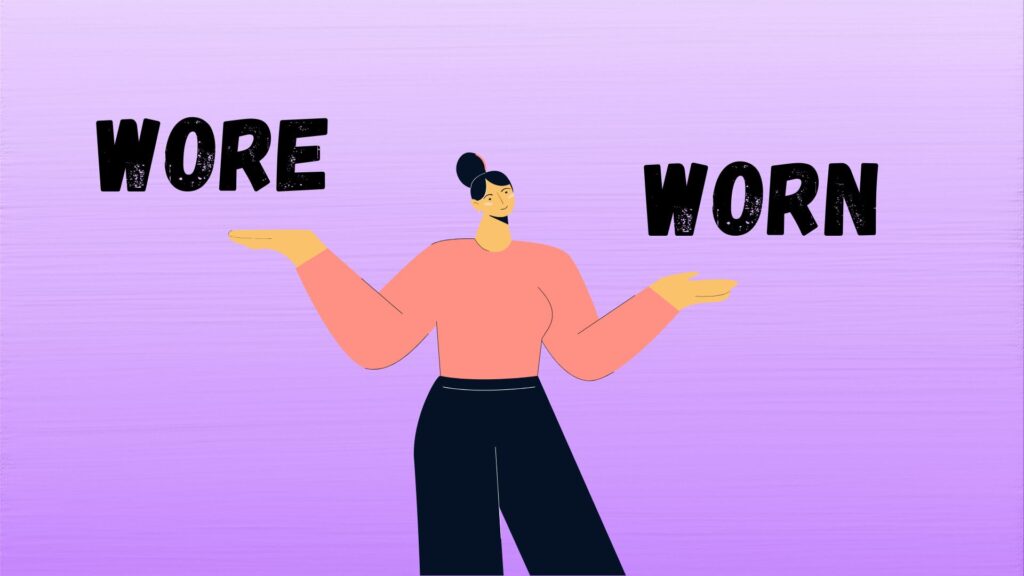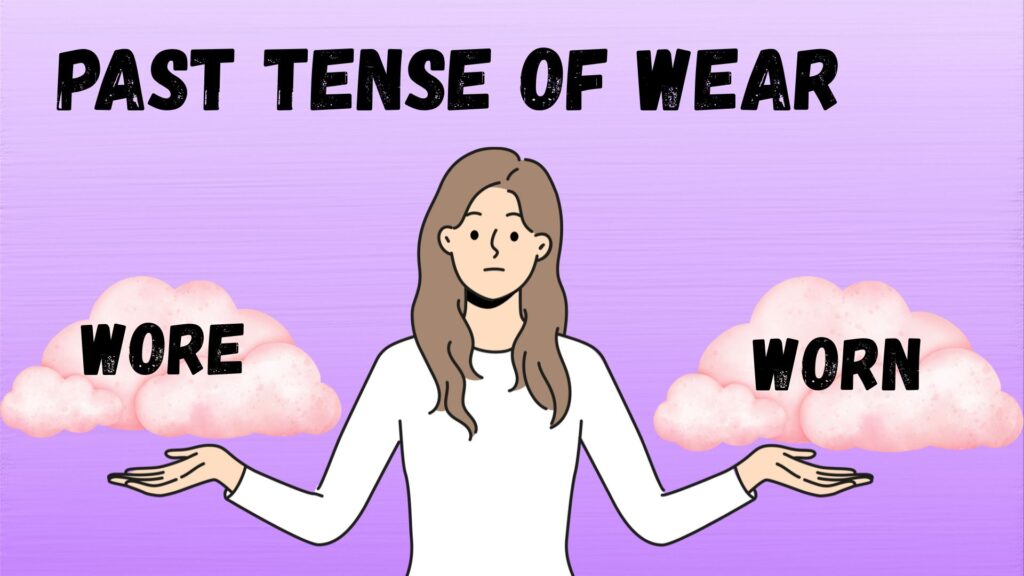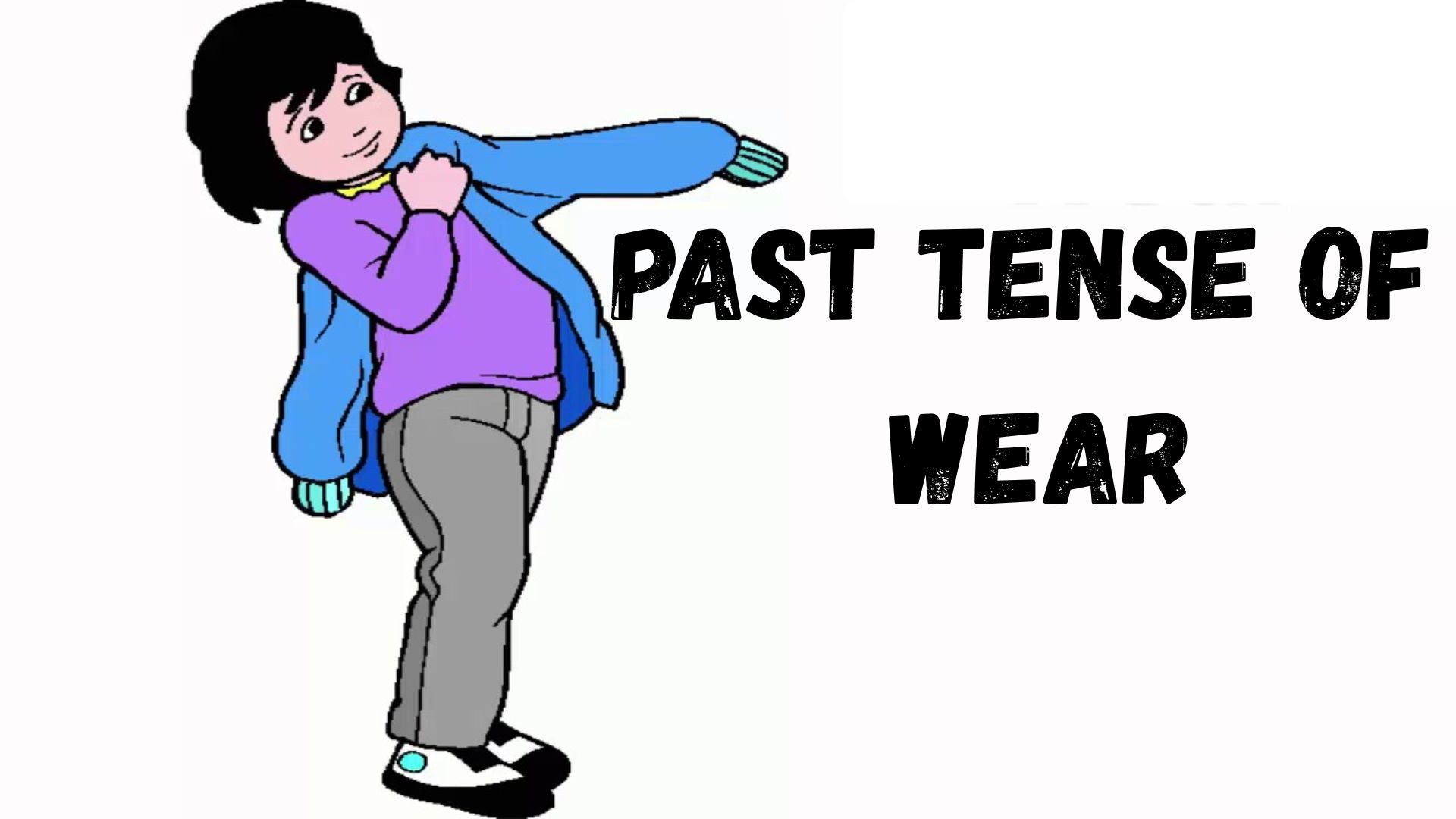Past Tense of Wear
If you’ve ever paused mid-sentence wondering, “Is it wore or worn?” you’re not alone. These two forms trip up native speakers and English learners alike. They both come from the verb wear, but they’re used in different grammatical contexts. So how do you know which one is correct?
Let’s break it down with examples, grammar insights, and a few helpful scenarios that’ll make this second nature.
Understanding the Verb “Wear”

At its root, the verb wear means to have something on your body like clothes, jewelry, or even a look on your face. But it also branches into idiomatic expressions like wear thin, wear your welcome, and the worse for wear.
Wear is an irregular verb, which means its past tense and past participle don’t follow the usual “-ed” pattern.
Verb Forms of “Wear”
| Tense | Form | Example |
|---|---|---|
| Base form | wear | I wear jeans every day. |
| Simple past | wore | Yesterday, I wore a hoodie. |
| Past participle | worn | She has worn that dress before. |
| Present participle | wearing | He’s wearing a new jacket. |
Notice that “weared” is never correct. It’s a common mistake, especially for learners, but it doesn’t belong in any tense.
When to Use “Wore”
Use wore when you’re speaking in the simple past tense. That means you’re talking about something that already happened, without needing a helper verb like “have” or “had.”
🔹 Structure: Subject + wore + object
✅ Examples:
- I wore my red heels to the gala.
- Mike wore his grandfather’s watch on graduation day.
- She wore a smile despite the bad news.
📧 Scenario Example (Email):
Subject: Dress Code Clarification
Hi Rachel,
Just a quick follow-up on yesterday’s meeting. I noticed several team members wore sneakers with their business casual outfits. Are we adjusting the policy, or should I remind everyone of the standard dress code?
Thanks,
Ethan
When to Use “Worn”
Worn is the past participle form. It always needs an auxiliary verb like have, has, or had before it. It shows up in perfect tenses or passive constructions.
🔹 Structure: Subject + have/has/had + worn + object
✅ Examples:
- I have worn these jeans for three days straight.
- She had worn that necklace every day until it broke.
- The uniforms have been worn down by daily use.
📧 Scenario Example (Message to HR):
Subject: Uniform Replacement Request
Hi Karen,
Several employees have mentioned that their safety gear has worn out over time. In particular, the gloves and boots look like they’ve been worn past their useful lifespan.
Could we request replacements for the warehouse team?
Best,
Naomi
Common Grammar Mistakes with “Wear”
Here are a few missteps people often make:
| Incorrect | Correct |
|---|---|
| She worn a sweater today. | She wore a sweater today. |
| They weared uniforms. | They wore uniforms. |
| You have wore that shirt. | You have worn that shirt. |
The mistake usually comes from mixing up tenses or misunderstanding auxiliary verbs.
Perfect Tense Cheat Sheet
| Tense | Use | Example |
|---|---|---|
| Present perfect | Past event with relevance to the present | I have worn glasses since 2010. |
| Past perfect | Action completed before another past event | He had worn braces as a teen. |
| Future perfect | Action completed before a future point | She will have worn heels all day. |
Wore vs. Worn in Everyday Language

To make things stick, let’s compare these forms in real-world scenarios.
🔸 Wore (Simple Past)
“Last night, Jake wore a tuxedo for the awards dinner.”
There’s no need for an auxiliary verb here. The action happened and is over.
🔸 Worn (Past Participle)
“By the end of the night, Jake’s tie had worn thin.”
Here, the verb pairs with had you’re describing a condition resulting from something that happened earlier.
Idioms and Expressions with “Wear”
English is packed with idioms that use the verb wear, and knowing these makes your language richer.
| Idiom | Meaning | Example |
|---|---|---|
| wear your heart on your sleeve | Be openly emotional | She always wears her heart on her sleeve. |
| the worse for wear | In poor condition | The sofa looks a bit the worse for wear. |
| wear thin | Lose impact or patience | His excuses are starting to wear thin. |
| wear your welcome | Overstay or annoy by staying too long | I didn’t want to wear my welcome, so I left. |
| to wear a long face | Look sad or disappointed | Why do you wear such a long face today? |
| normal wear and tear | Expected deterioration over time | The apartment had only normal wear and tear. |
Etymology of “Wear”
The word wear dates back to Old English werian, meaning to clothe or cover. Its roots trace even deeper to Proto-Germanic gawasjan and Proto-Indo-European (PIE) roots like wes- meaning to clothe. Over centuries, “wear” has kept its core meaning while expanding into metaphorical and idiomatic usage.
Quick Grammar Tips

- Always pair participles with an auxiliary verb (e.g., has worn, had worn).
- Use “wore” when you’re keeping it simple and referring to the past directly.
- Never say “weared” it’s not a word in standard English.
- Look for verb conjugation clues: if there’s a “have,” you’re probably looking for the past participle.
Recap: Wore vs. Worn
| Use It When… | Choose: Wore | Choose: Worn |
|---|---|---|
| Describing a simple past action | ✅ I wore boots yesterday. | ❌ I worn boots yesterday. |
| Using perfect tenses | ❌ I wore that before. | ✅ I have worn that before. |
| With “have,” “has,” or “had” | ❌ He had wore a hat. | ✅ He had worn a hat. |
| Using passive constructions | ❌ It was wore daily. | ✅ It was worn daily. |
Final Thoughts
If you’re still unsure, remember this trick:
If there’s a helper verb like have, has, or had you need worn. Otherwise, go with wore.
Mastering irregular verbs like wear, wore, and worn is a huge step toward fluency. Whether you’re writing a professional email or just chatting with friends, using the correct verb form helps you sound natural and confident.

